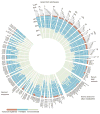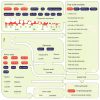Genome-wide association study identifies multiple loci influencing human serum metabolite levels
- PMID: 22286219
- PMCID: PMC3605033
- DOI: 10.1038/ng.1073
Genome-wide association study identifies multiple loci influencing human serum metabolite levels
Abstract
Nuclear magnetic resonance assays allow for measurement of a wide range of metabolic phenotypes. We report here the results of a GWAS on 8,330 Finnish individuals genotyped and imputed at 7.7 million SNPs for a range of 216 serum metabolic phenotypes assessed by NMR of serum samples. We identified significant associations (P < 2.31 × 10(-10)) at 31 loci, including 11 for which there have not been previous reports of associations to a metabolic trait or disorder. Analyses of Finnish twin pairs suggested that the metabolic measures reported here show higher heritability than comparable conventional metabolic phenotypes. In accordance with our expectations, SNPs at the 31 loci associated with individual metabolites account for a greater proportion of the genetic component of trait variance (up to 40%) than is typically observed for conventional serum metabolic phenotypes. The identification of such associations may provide substantial insight into cardiometabolic disorders.
Conflict of interest statement
The authors declare no competing financial interests.
Figures


Comment in
-
Genome-wide genetic association study meets systematic metabolite screening.Circ Cardiovasc Genet. 2012 Aug 1;5(4):479-80. doi: 10.1161/CIRCGENETICS.112.964239. Circ Cardiovasc Genet. 2012. PMID: 22896017 No abstract available.
References
Publication types
MeSH terms
Substances
Grants and funding
- R01 HL087679/HL/NHLBI NIH HHS/United States
- R01 AA009203/AA/NIAAA NIH HHS/United States
- 1RL1MH083268/MH/NIMH NIH HHS/United States
- 5R01HL087679/HL/NHLBI NIH HHS/United States
- 89061/Z/09/Z/WT_/Wellcome Trust/United Kingdom
- AA-12502/AA/NIAAA NIH HHS/United States
- R01 AA015416/AA/NIAAA NIH HHS/United States
- 098051/WT_/Wellcome Trust/United Kingdom
- AA-15416/AA/NIAAA NIH HHS/United States
- GR069224/WT_/Wellcome Trust/United Kingdom
- K02 AA018755/AA/NIAAA NIH HHS/United States
- 090532/WT_/Wellcome Trust/United Kingdom
- G0500539/MRC_/Medical Research Council/United Kingdom
- R01 AA012502/AA/NIAAA NIH HHS/United States
- AA-08315/AA/NIAAA NIH HHS/United States
- RL1 MH083268/MH/NIMH NIH HHS/United States
- 089062/Z/09/Z/WT_/Wellcome Trust/United Kingdom
- G0600705/MRC_/Medical Research Council/United Kingdom
- R37 AA012502/AA/NIAAA NIH HHS/United States
LinkOut - more resources
Full Text Sources
Other Literature Sources
Medical

